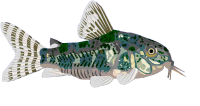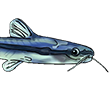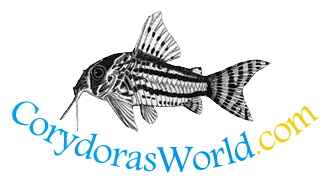What Does The Cw Mean?
-
bronzefry
- Posts: 2198
- Joined: 31 Aug 2004, 16:01
- I've donated: $100.00!
- My articles: 6
- My images: 12
- My cats species list: 17 (i:0, k:0)
- My aquaria list: 7 (i:7)
- Spotted: 6
- Location 1: Sharon, Massachusetts, US
What Does The Cw Mean?
I noticed on some of the new Corydora spp. yet to be described, there is a designation "Cw." Does anybody know what the "Cw" stands for?
Thanks,
Amanda
Thanks,
Amanda
- Dave Rinaldo
- Posts: 2178
- Joined: 31 Dec 2002, 10:49
- I've donated: $601.00!
- My images: 238
- My cats species list: 64 (i:0, k:0)
- Spotted: 97
- Location 2: Austin, Texas
-
bronzefry
- Posts: 2198
- Joined: 31 Aug 2004, 16:01
- I've donated: $100.00!
- My articles: 6
- My images: 12
- My cats species list: 17 (i:0, k:0)
- My aquaria list: 7 (i:7)
- Spotted: 6
- Location 1: Sharon, Massachusetts, US
- Jools
- Expert
- Posts: 16277
- Joined: 30 Dec 2002, 15:25
- My articles: 198
- My images: 941
- My catfish: 237
- My cats species list: 87 (i:13, k:1)
- My BLogs: 7 (i:10, p:167)
- My Wishlist: 23
- Spotted: 450
- Location 1: Middle Earth,
- Location 2: Scotland
- Interests: All things aquatic, Sci-Fi, photography and travel. Oh, and beer.
- Contact:
There's a L/LDA number parallel here. DATZ are still publishing some new c-numbers, but, as ever, it's hard to find out about them unless you can read, or have the time to translate, German. Annoyingly, it also means that one new species can exist in both number schemes again like L/LDA numbers - but I can't do much about that.
Unlike the LDA numbers which were increasingly hard to find pictures of for free - I've agreed with Ian that we'll run CW-numbers here and he will facilitate new additions as they arrive.
Jools
Unlike the LDA numbers which were increasingly hard to find pictures of for free - I've agreed with Ian that we'll run CW-numbers here and he will facilitate new additions as they arrive.
Jools
Owner, AquaticRepublic.com, PlanetCatfish.com & ZebraPleco.com. Please consider donating towards this site's running costs.
-
Bas Pels
- Posts: 2918
- Joined: 21 Dec 2006, 20:35
- My images: 1
- My cats species list: 28 (i:0, k:0)
- Spotted: 8
- Location 1: the Netherlands
- Location 2: Nijmegen the Netherlands
- Interests: Central American and Uruguayan fishes
As so many good books on fishkeeping are written in German, I'd say - learn the language.Jools wrote:but, as ever, it's hard to find out about them unless you can read, or have the time to translate, German.
It does look much more complicated than it really is. Naturally, being Dutch, my language is most relatede to German, but the third close language in Egnlish - thus for English speaking people German should not be too hard.
-
Coryologist
- Posts: 561
- Joined: 09 Nov 2003, 13:10
- I've donated: $200.00!
- My images: 11
- My cats species list: 70 (i:0, k:0)
- Spotted: 5
- Location 1: Laurel Lake, NJ
- Location 2: Laurel Lake, NJ
- Interests: Fancy Guppies, Cory Cats, Digital Photography, DV, Triumph Motorcycles
Learn German.
You're kidding, right? I haven't mastered English, yet.Bas Pels wrote:As so many good books on fishkeeping are written in German, I'd say - learn the language.Jools wrote:but, as ever, it's hard to find out about them unless you can read, or have the time to translate, German.
It does look much more complicated than it really is. Naturally, being Dutch, my language is most relatede to German, but the third close language in Egnlish - thus for English speaking people German should not be too hard.
I used to be schizophrenic, but we're OK now. At least that's what my dog is always telling me!
Hear podcasts of "Sounds Fishy to Me," here: http://www.aquaradio.net
Hear podcasts of "Sounds Fishy to Me," here: http://www.aquaradio.net
-
bronzefry
- Posts: 2198
- Joined: 31 Aug 2004, 16:01
- I've donated: $100.00!
- My articles: 6
- My images: 12
- My cats species list: 17 (i:0, k:0)
- My aquaria list: 7 (i:7)
- Spotted: 6
- Location 1: Sharon, Massachusetts, US
- MatsP
- Posts: 21038
- Joined: 06 Oct 2004, 13:58
- My articles: 4
- My images: 28
- My cats species list: 117 (i:33, k:0)
- My aquaria list: 10 (i:8)
- My BLogs: 4 (i:0, p:164)
- Spotted: 187
- Location 1: North of Cambridge
- Location 2: England.
It is probably not the hardest language to learn enough to understand. But when it comes to technical stuff like fish-literature, it gets more complicated than just knowing the basics of the language - heck, even in English it can be a challenge sometimes.Bas Pels wrote:It does look much more complicated than it really is. Naturally, being Dutch, my language is most relatede to German, but the third close language in Egnlish - thus for English speaking people German should not be too hard.
Being born in Sweden, I studied English from the age of 9 or 10 until I left school at 20, and German for two years around 16-17 or so.
I can usually figure out if I get fish, pork, beef or chicken on a German menu, and I can get something to drink that matches my taste and the meal. I can also understand what someone is talking about if I know the subject. And I can read MOST of what is said on a web-page or some magazine article. Unfortunately, it's often the 10-20% that I don't get that are important!
--
Mats
- Coryman
- Expert
- Posts: 2119
- Joined: 30 Dec 2002, 19:06
- My articles: 12
- My catfish: 5
- My cats species list: 83 (i:0, k:0)
- My BLogs: 1 (i:0, p:46)
- Spotted: 194
- Location 1: Kidderminster UK
- Location 2: Kidderminster, UK
- Interests: Cory's, Loricariids, photography and more Cory's
- Contact:
CW-numbers
Before the topic goes off into a lengthy debate about the languages, I would like to explain my reasoning for introducing CW (Corydoras World) -numbers.
The original C-number system was produced and controlled by DATZ magazine and Hans-Georg Evers, fishes which were allocated numbers were those new, or thought to be new undescribed species that were coming into the hobby at quite an alarming rate. The scientific process is quite slow and therefore a system that enables us to recognise a species by a common factor is good and avoids a lot of confusion. Hans-Georg as I now believe no longer has any involvement with DATZ and the allocation of new C-numbers has been pretty stagnant over the last 18 months, with only one number being issued. Because there have not been any new C-numbers did not mean that there were no new species coming into the hobby, in fact there have been plenty. So, with some 15 or 16 potentially new species being well distributed in the hobby in the last year I decided to put a new section on my site to aquatint the members with these species and in doing so it automatically creates a numeric list. There are now 30 species on the list.
It was never my intention to try and replace the C-number system, but to compliment it. If DATZ issue more numbers to species I have allocated CW-numbers to then I will simply add the species to the C-number page and cross link the two numbers.
What I have done, which is a little different, is to add some of the well established species that have been in the hobby for many years and because their original location in unknown, or in doubt at the very best, they will in all probability never be described.
There should never be a conflict between the two systems as any new C-numbers will not be issued with a CW-number unless it was issued first and then as I have already stated it will be placed in C-numbers and linked.
If anyone is still unclear feel free to ask questions.
Ian
The original C-number system was produced and controlled by DATZ magazine and Hans-Georg Evers, fishes which were allocated numbers were those new, or thought to be new undescribed species that were coming into the hobby at quite an alarming rate. The scientific process is quite slow and therefore a system that enables us to recognise a species by a common factor is good and avoids a lot of confusion. Hans-Georg as I now believe no longer has any involvement with DATZ and the allocation of new C-numbers has been pretty stagnant over the last 18 months, with only one number being issued. Because there have not been any new C-numbers did not mean that there were no new species coming into the hobby, in fact there have been plenty. So, with some 15 or 16 potentially new species being well distributed in the hobby in the last year I decided to put a new section on my site to aquatint the members with these species and in doing so it automatically creates a numeric list. There are now 30 species on the list.
It was never my intention to try and replace the C-number system, but to compliment it. If DATZ issue more numbers to species I have allocated CW-numbers to then I will simply add the species to the C-number page and cross link the two numbers.
What I have done, which is a little different, is to add some of the well established species that have been in the hobby for many years and because their original location in unknown, or in doubt at the very best, they will in all probability never be described.
There should never be a conflict between the two systems as any new C-numbers will not be issued with a CW-number unless it was issued first and then as I have already stated it will be placed in C-numbers and linked.
If anyone is still unclear feel free to ask questions.
Ian






